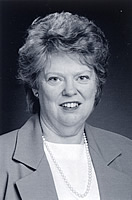Gerontology
Director Participates in White House Conference on Aging
Conference addressed workforce issues
such as training healthcare workers who provide services to
seniors and strengthening Medicare and Medicaid.
December 22, 2005 :: No. 94
They were expected to
be visionary, healthy and engaged. “They” are the 1,200 delegates who
were invited to this month’s White House Conference
on Aging to develop recommendations on policy issues affecting
older people.
Pauline Abbott, director of the Institute
of Gerontology at Cal State Fullerton,
was a California delegate to the 2005 White House Conference on Aging Dec 9-14.
Named to the delegation by Congressman Ed Royce (R-Fullerton), Abbott is particularly
interested in work force issues as they relate to older Americans.
Of 73 resolutions presented to the delegates, 10 top priorities were selected.
These include addressing work force issues, such as capacity-building and training
for healthcare workers who will provide services to seniors; developing work
force opportunities with “friendly” policies toward older workers;
ensuring options for transportation to further seniors’ independence; and
strengthening Medicare and Medicaid. Reauthorization of the Older Americans Act
also was recommended.
“As the baby boomers begin to retire and as life expectancy continues to
increase, we’re going to have to re-think our ideas about retirement,” Abbott
said. “Today, retirees are active much longer and want to be involved in
areas of civic engagement. They want to be contributing members of society.
“However, after they leave a profession, there is a tendency for them to
leave their professional activities as well,” she continued. “If
they are serving on boards, often their board service concludes with their paid
jobs. So what can they do? They can go the traditional routes of taking volunteer
positions where they stuff envelopes or participate on hospitality committees,
but many of the newly retired are interested in different challenges. They have
been leaders in their respective fields, and they’re looking for new challenges.”
This exodus from professional development also isn’t good for communities,
Abbott believes. “These are people with incredible experience and insight,” she
said. “It creates a void for society and the individual not to tap into
that expertise.”
Abbott contends that Americans should re-think the work force structure and look
for new models. “For instance, here at Cal State Fullerton, professors
have the option of what we call ‘FERPing’ [Faculty Early Retirement
Program] where they can teach part time for up to five years,” she said. “This
same sort of model might be very effective in business and other industries as
well.”
Another area of interest to Abbott is care giving. As a caregiver for her own
aging mother, it’s an issue she understands personally, as well as in her
role as director of the university’s Institute of Gerontology.
“Long-term care needs during the aging years are going to become increasingly
important,” she said. “Not everyone who lives a long life is going
to be able to do so without assistance. So who is the caregiver? What if the
person never married or had children, who tend to be the typical caregivers?
What if the spouse or children are unable or unwilling to care for their aging
family members?
“What happens when the care giving becomes too much for the caregiver?
Women, who have historically been the caregivers because they were at home, are
now often members of the work force. This has a great effect on care giving for
aging relatives.
“During our discussions, we focused on critical issues,” Abbott explained. “What
can we, as a country, do to help shape the future? We also had to look at competing
interests. We don’t want to perpetuate the notion of ‘greedy geezers.’ There
has to be intergenerational equity.
“We’re looking at changes that we hope to implement, or at least
begin, within the next 10 years,” she added. “We realize that with
a larger population reaching retirement — it is estimated that there are
77 million baby boomers — there will be a broader impact on society. We
need to shape and frame debate on public policy issues as they relate to the
elderly.
“The issues we addressed cover not only the seniors of today but the ‘tsunami’ of
seniors who will begin to turn 65 in five years. We will prepare a final report
that will be submitted to the President and Congress as guidelines for policy
over the next decade.”
The White House Conference on Aging originated in 1961 and convenes each decade.
| Media Contacts: |
Pauline Abbott, Institute of Gerontology, 657-278-4686
or pabbott@fullerton.edu
Valerie
Orleans, Public Affairs, 657-278-4540 or vorleans@fullerton.edu
|
«
back to News Front
|

Pauline Abbott
|
| Get Expert Opinions On... |
|
 |
| |
|